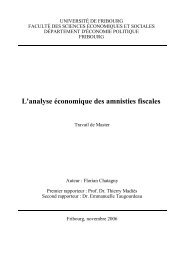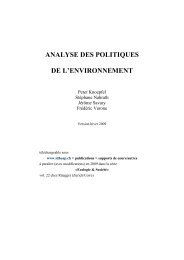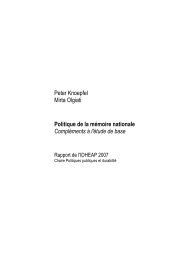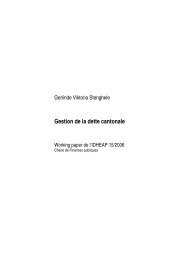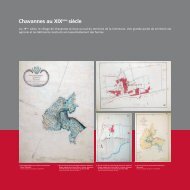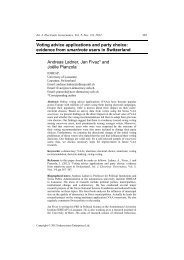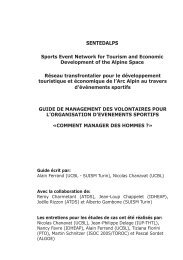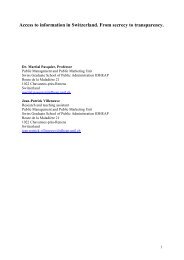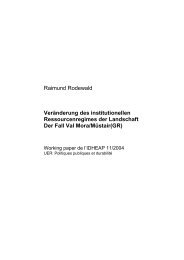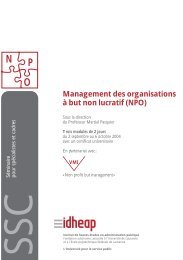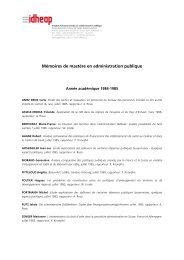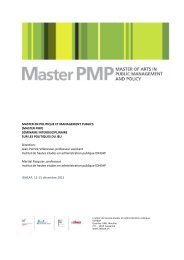Historical Analysis of Institutional Regimes in Switzerland ... - IDHEAP
Historical Analysis of Institutional Regimes in Switzerland ... - IDHEAP
Historical Analysis of Institutional Regimes in Switzerland ... - IDHEAP
Create successful ePaper yourself
Turn your PDF publications into a flip-book with our unique Google optimized e-Paper software.
17<br />
course <strong>of</strong> the 1980s, as any reductions achieved by means <strong>of</strong> technological developments were<br />
outweighed by <strong>in</strong>creases <strong>in</strong> the volumes <strong>of</strong> vehicular traffic. Control <strong>of</strong> the emissions structure by<br />
means <strong>of</strong> regional development is <strong>in</strong>creas<strong>in</strong>gly be<strong>in</strong>g adapted <strong>in</strong> efforts to resolve local-supralocal air<br />
pollution problems (development <strong>of</strong> settlement areas on the outskirts <strong>of</strong> town centres). In addition, a<br />
wide variety <strong>of</strong> direct <strong>in</strong>terventions <strong>in</strong> private and goods traffic has been implemented rang<strong>in</strong>g from<br />
orders and prohibitions (traffic regulation), <strong>in</strong>centive systems (traffic tax, road pric<strong>in</strong>g etc.) to direct<br />
<strong>in</strong>frastructure services (development <strong>of</strong> public transport with a view to chang<strong>in</strong>g the modal split). The<br />
heterogeneous group <strong>of</strong> motor vehicle users, which can no longer be controlled us<strong>in</strong>g <strong>in</strong>dividual<br />
measures, is becom<strong>in</strong>g the object <strong>of</strong> efforts to establish collective regulation (vehicle fitt<strong>in</strong>gs, fuel<br />
composition) as well as <strong>in</strong>centive systems and campaigns.<br />
IR type: we def<strong>in</strong>e the IR for the resource air as complex because the policy design has become<br />
highly differentiated over time - new target groups and additional <strong>in</strong>struments were added - and<br />
because <strong>in</strong>itial attempts were made to def<strong>in</strong>e and distribute use rights (see example <strong>of</strong> environmental<br />
certificates <strong>in</strong> the two Basle cantons or the proposed CO 2 and non-renewable energy taxes).<br />
Property and use rights are still not properly def<strong>in</strong>ed.<br />
c) Water (complex IR)<br />
Goods and services: The goods and services provided by the resource water <strong>in</strong>clude a liv<strong>in</strong>g<br />
environment for plants and animals (food and reproduction), dr<strong>in</strong>k<strong>in</strong>g water, water used directly or<br />
<strong>in</strong>directly for the production <strong>of</strong> economic goods (e.g. irrigation, water-cool<strong>in</strong>g for nuclear plants,<br />
dra<strong>in</strong>age, m<strong>in</strong>eral water), hydro-electric power (particular form <strong>of</strong> water use for the economic<br />
production), water purification, support for economic production and recreation (e.g. navigation,<br />
gravel extraction, fish<strong>in</strong>g), recreation (leisure and tourism), medical uses (e.g. water cures) and<br />
geomorphologic changes and protection (natural hazards). All these goods and services could be<br />
theoretically regulated by public policy and/or property and use rights. Water management <strong>in</strong><br />
<strong>Switzerland</strong> currently faces five ma<strong>in</strong> challenges: (1) the problem <strong>of</strong> <strong>in</strong>creas<strong>in</strong>g competition or rival<br />
uses <strong>of</strong> water (<strong>in</strong> most regions, the spectrum <strong>of</strong> water uses has become more heterogeneous over the<br />
past last decades); (2) the problem <strong>of</strong> phreatic and lacustr<strong>in</strong>e water quality (related to diffuse<br />
pollution); (3) the question <strong>of</strong> m<strong>in</strong>imal residual flows; (4) the problem <strong>of</strong> <strong>in</strong>creas<strong>in</strong>gly impervious soils<br />
(waterpro<strong>of</strong><strong>in</strong>g) <strong>in</strong> settlements (general water plann<strong>in</strong>g at a local-authority scale); (5) the question <strong>of</strong><br />
natural hazards related to water (floods, permafrost and glacier degradation, debris flows). These<br />
five types <strong>of</strong> problem do not affect the entire country with the same <strong>in</strong>tensity (e.g. water quality<br />
problems <strong>in</strong> lakes are typical <strong>of</strong> the rural areas <strong>of</strong> the Central Plateau; the question <strong>of</strong> m<strong>in</strong>imal flows<br />
or some climatic hazards are more common <strong>in</strong> the Alp<strong>in</strong>e belt; <strong>in</strong>creas<strong>in</strong>g competition between uses<br />
is typical <strong>of</strong> urbanised and tourist areas, etc.).<br />
Property Rights: Around 1850, regulations concern<strong>in</strong>g water rights were the almost exclusive<br />
preserve <strong>of</strong> cantonal civil law. The Swiss Confederation did not have exclusive competence to pass<br />
civil laws for all <strong>of</strong> <strong>Switzerland</strong> until 1898. Prior to that, the <strong>in</strong>dividual cantons were responsible for<br />
their own civil law. After the <strong>in</strong>troduction <strong>of</strong> the Swiss Civil Code <strong>in</strong> 1912, the cantons could only<br />
pass civil law regulations concern<strong>in</strong>g property <strong>in</strong> exceptional cases. In general, however, the legal<br />
distribution <strong>of</strong> property and use rights to waters was not completely uniform. Spr<strong>in</strong>gs, small sources<br />
<strong>of</strong> ground water and artificially created water bodies constitute part <strong>of</strong> basic property <strong>in</strong> accordance<br />
with the pr<strong>in</strong>ciple <strong>of</strong> accession (Article 667 Swiss Civil Code). Large lakes, streams or rivers do not,<br />
however, observe site boundaries. Thus, <strong>in</strong> the case <strong>of</strong> other water bodies, the basic assumption is



